|
Memphis
Exposition Building |
|
... another
forgotten
historic building |
|
|
|
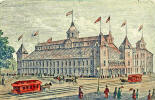 |
Several
years ago we came across this illustration of the then unknown
Memphis Exhibition Building. After some preliminary
research we found no information about the building or about its
location. Recently while exploring some vintage Daily Appeal
Newspapers we came across several ads featuring the same
illustration and learned that the building was actually located at
Jefferson and 4th. Then we came across a featured article
announcing that the hall would be built in 1872 and we learned that
it's major use was to host a yearly Memphis "Industrial Exposition".
Now more of the story can be filled in ... |
|
Memphis
Exposition Building |
|
|
|
|
|
|
|
| |
|
Click on small photos to
enlarge them. |
|
|
|
|
| |
|
|
|
From 1870 to 1888 almost every major city in the U.S. held an
Industrial Exposition. This was the time of great growth
in the country and the spirit of new inventions was everywhere.
That's what the Industrial Expositions were all about. To
sponsor these expositions, city governments built huge, special
buildings to house them. And Memphis was no exception.
In 1872 the Memphis Daily Appeal ran a front page article
announcing that the city would build a great Exposition Hall on
Jefferson and the SW corner of 4th. The main entrance
would be on Jefferson, with additional entrances on 4th and on
Court. |
 |
| |
1872
Announcement |
|
| |
 |
The
architect was James B. Cook, who had designed the new Gayoso
Hotel after the first one burned. He had also designed the
original Shelby County Jail and several of the grand churches of
the city. The huge barn-like building was ready to open in
short time and the first Industrial Exposition opened October
12, 1872. It was a big success and new exhibitions would
appear every year through 1888 - each one larger than the last.
When the building was dedicated in 1872, the reviews were
very positive - "... a noble structure". "The result ... is the
erection of a palace so grand in its extent, so harmonious in
its details, and in every way so adapted to the purpose for
which it is intended, that the smile of quiet adoration is
exchanged for the astonished gaze of admiration."
"... a true temple of glory". "... unmixed
admiration." |
| James B. Cook |
|
|
| |
|
|
| |
|
The
complete 1872
dedication
ceremony
is posted above. It completely describes the interior of the
building. (The file is quite large and may be slow to open).
The exhibition hall was expanded twice, adding a "Floral Hall with
Glass Roof" and a "Power Hall" to accommodate large machinery.
Over time the expositions included displays from every conceivable
business. Artists displayed their works, musicians performed,
and inventors and other businesses displayed their wares. It
was the perfect way to illustrate Memphis' important contributions
to culture and technology in the 1800s. And it was heavily
advertised in the daily newspapers. |
|
|
|
|
| |
|
| |
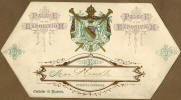 |
 |
Although each exposition lasted only one month the Memphis
Exposition Hall was used year-round. After an exposition
closed the hall was used for huge Masked Balls during Carnival,
Christmas, and special occasions. Seats were brought in
and the great halls were then used for Vaudeville acts and
theatre performances and circuses. Conventions were held
there. And toward the end of its life, the hall found the
perfect use - as a roller skating rink. |
|
Masked Balls 1779
|
Masked Balls |
|
|
| |
|
|
|
|
|
|
|
|
| |
| |
| |
| |
|
What
happened to the Exposition Building?
It
isn't listed in the Memphis Directories after 1888, so this
being Memphis, it's safe to say that it was demolished.
But typically, there are no details and to date, we have not
been able to locate a single exterior photograph of the
building. |
 |
 |
 |
 |
| |
1876 Directory |
1878 |
1883 |
1886 |
|
| |
|
Update May 12,
2021 .
Lucius McGehee writes:
I
found these items in the old Memphis Daily Appeal of 1887.
They document that our grand Exposition Building was pulled
down over a few days that summer. The Appeal calls it,
inevitably, "that old eyesore". Sic transit gloria mundi!
(Thus passes wordly glory)
Thank you Lucius for helping us complete our story on the old
Exposition Burilding. |
 |
|
| |
|
|
| |
| |
| |
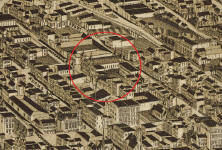 |
Vintage
City Map showing the Exposition Building.
November 4, 2015: Memphian Paul Roach has an eagle eye and
spotted this detail of the Expo Building on an 1888 map of
Memphis. Thank you Paul. You've helped us with
information and photos in the past, and we are very grateful. |
| 1888 City Map |
|
|
|
|
|
|
|
| |
|
|
|
Brief
History of the Industrial Expositions ... |
|
|
|
|
|
The first Exposition in the US was held in Cincinnati in 1838.
It was actually a Fair of the Ohio Mechanics Institute held in
the nation's first permanent exhibition hall. It drew citizens
from far and wide to look at industrial products. Chicago might
dispute who held the first expo. but eighteen more of these
fairs were held in Cincinnati before the Civil War. After the
war, the Ohio Mechanics Institute joined with the Chamber of
Commerce to hold expositions to try to jumpstart their economy.
By 1870 they held their first GRAND Industrial Exposition in a
new building especially designed for expos. |
 |
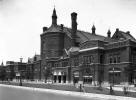 |
| |
Poster |
Cincinnati Bldg |
|
| |
|
|
|
|
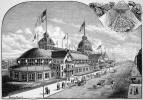 |
|
Chicago
|
|
Other cities began holding similar expos, and building similar
Exposition Halls - some grander than others, but all were based
on the same principal - they needed to be large and impressive
and able to be built quickly. Every branch of manufacture in
the city and vicinity was to be included. And the guidelines
were specific - stating that they must advertise extensively to
insure crowded halls. Awards would encourage exhibitors to
prepare extravagant displays. Medals and diplomas were given
for important machines capable of producing marketable items.
Their were often elaborate halls of arts and industries
displaying everything from kitchen stoves to enormous
horticultural arrangements. The departments of natural history
embraced all aspects of the natural world. |
|
|
|
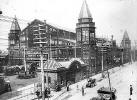 |
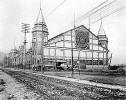 |
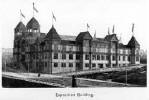 |
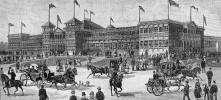 |
|
New York
|
Pittsburgh |
Tacoma |
Atlanta |
|
|
|
|
The exhibition had to be housed in a building especially designed
and built for this purpose. One did not take an old building
and convert it into these buildings. The buildings were often
constructed within a period of 6 to 8 months. |
|
|
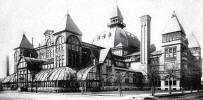 |
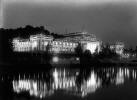 |
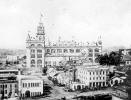 |
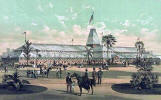 |
|
Milwaukee
|
Knoxville |
Minneapolis |
New Orleans |
|
| |
| |
|
| |
| |
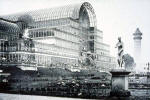 |
And then there were the international
expositions, which generally began with London's famous Crystal
Palace in 1851. It's stated plan was "to illustrate British
Industrial Development". Since other nations were invited
to participate.
they each hoped to outdo each other. This exposition was so successful that
other Expos followed in the major cities of Europe. This, of
course led to the establishment of "World Fairs"... and then
after the success of the Industrial Expositions in the US, the
State Fairs began as a way to let rural America participate. With State Fairs, there was no longer a need
for the yearly Industrial Expositions. |
| 1751 London
Crystal Palace |
|
|
|
|
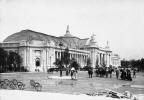 |
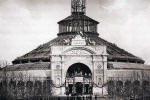 |
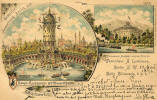 |
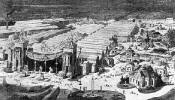 |
|
Paris - Gran
Palais
|
Vienna |
Berlin |
Amsterdam |
|
| |
| |
|
| |
| |
|
The
father of the Cincinnati expos was Alfred T. Goshorn. His
reputation at mounting successful expositions was so solid
that it led to his appointment as director general of the
International Centennial Exhibition in Philadelphia in
1876 - America's birthday celebration and the first
"World's Fair in the US" It was such a
resounding success that Queen Victoria knighted Goshorn
and the leaders of Europe presented him with numerous
accolades. After the close of the Philadelphia
Exposition, many of the items were shipped to Washington
to become a Smithsonian exhibit in its Arts and Industry
building. Today, several of the Philadelphia
Centennial buildings are still in use. |
 |
| |
A. T.
Goshorn |
|
|
|
|
|
|
|
| |
| |
|
|
|
|
|
|
|
|
|
|
|
|
|
|
|
|
|
|
|
|
|
|
|
|
|
Credits |
|
|
|
The
Historic-Memphis website does not intentionally post copyrighted
photos and material without permission or credit.
On
occasion a "non-credited" photo might possibly be posted because we
were unable to find a name to give credit. Because of the nature of
our non-commercial, non-profit, educational website, we strongly
believe that these photos would be considered "Fair Use. We have
certainly made no monetary gain, although those using this website
for historic or Genealogy research have certainly profited. If by
chance,
we have posted your copyrighted photo, please contact us, and we'll
remove it immediately, or we'll add your credit if that's your
choice. In the past, we have found that many photographers
volunteer to have their works included on these pages and we'll
also do that if you contact us with a photo that fits a particular
page. |
|
|
|
The "Historic-Memphis" website would like to acknowledge and thank the
following for their contributions which helped make this website
possible:
Memphis
Public Library, Memphis University Library, Memphis Law Library,
Memphis Commercial Appeal, Memphis Press Scimitar, Shelby County
Register of Deeds, Memphis City Schools, Memphis Business Men's
Club, Memphis Chamber of Commerce, Memphis City Park Commission,
Memphis Film Commision, Carnival Memphis, Memphis Historical
Railroad Page, Memphis Heritage Inc, Beale Street Historic District,
Cobblestone Historic District, Memphis Historic Districts, Vance
Lauderdale Family Archives, Tennessee State Archives, Library of
Congress, Kemmons Wilson Family, Richard S. Brashier, Lee Askew,
George Whitworth, Woody Savage and many individuals whose assistance is
acknowledged on the pages of their contributions. Special
thanks to Memphis Realtor, Joe Spake, for giving us carte blanche
access to his outstanding collection of contemporary Memphis photos.
We do not have high definition copies of the photos on these
pages. If anyone wishes to secure high definition photos,
you'll have to contact the photographer or the collector.
(To avoid any possibility of contributing to SPAM, we do not
maintain a file of email addresses for anyone who contacts us). |
|
|
|
|
|
|
|
|
<><><><><> |
|
|
|
|
|
|